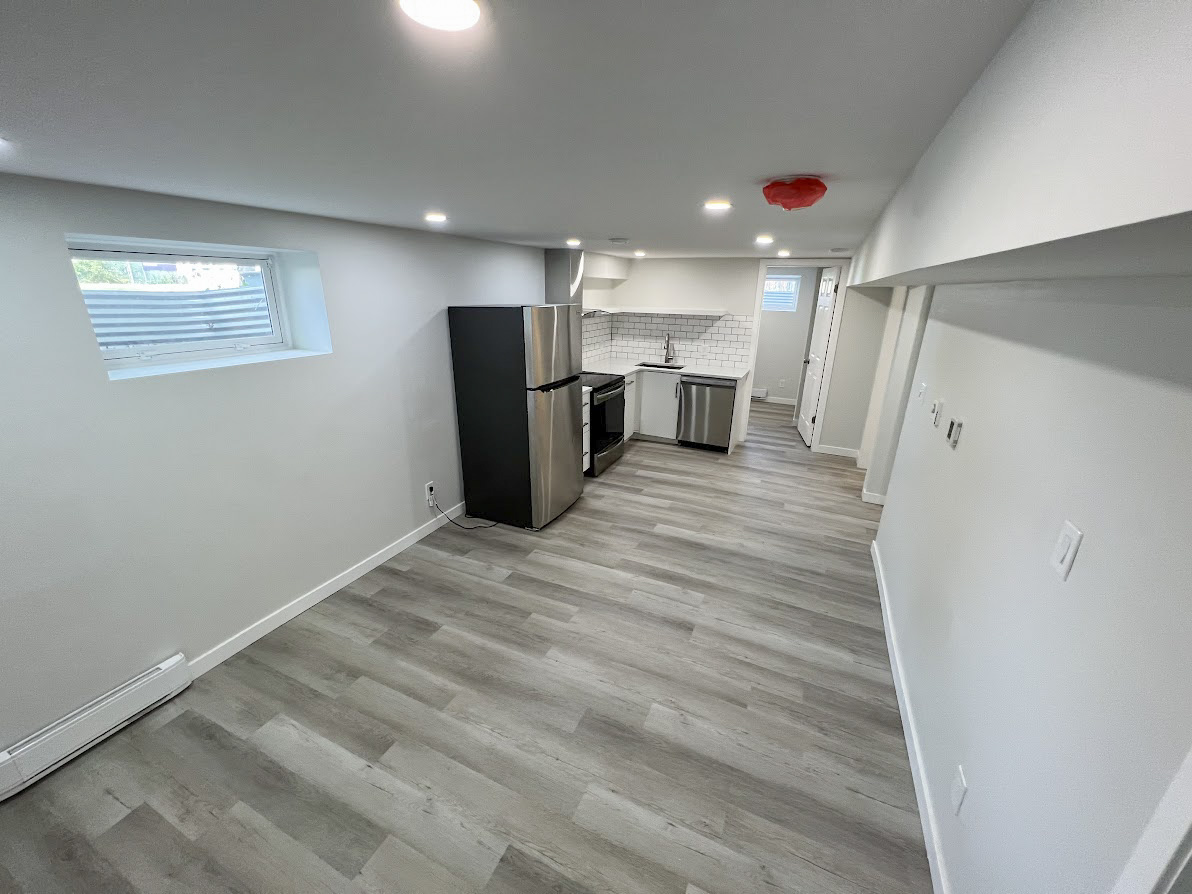Basement renovations are one of the most transformative home improvement projects you can undertake. Whether you’re looking to create more living space, build an entertainment area, add an office, or even develop an income-generating apartment, a finished basement offers endless potential.
However, navigating a renovation can feel overwhelming without a clear plan and the right information. That’s why we’ve put together this ultimate guide to basement renovations—so you can tackle your project with confidence and turn your basement into the dream space you’ve always envisioned.
In this guide, we will cover everything you need to know—from planning and addressing challenges to designing, insulating, and adding those all-important finishing touches. Let’s dive in!
Planning Your Basement Renovation
Before you start knocking down walls and purchasing materials, it’s important to create a solid plan. Basement renovations can be overwhelming, especially if you don’t have a clear idea of your goals. A well-thought-out plan will save you time and money and ensure that you’re happy with the final result.
Step 1: Assess The Existing Space
The first thing to consider is the condition of your basement. Does it have moisture issues? Are there any cracks in the basement walls? Are the floor joists in good condition? Take the time to inspect these areas thoroughly to understand what work is needed before you begin your renovation.
Step 2: Define Your Purpose
What do you want to achieve with your renovation? Do you want a family room, guest suite, home office, or even a rental unit? This will greatly influence the design and layout of your space. If you’re unsure, start by brainstorming and considering how you and your family will use the space.
Step 3: Create A Budget And Timeline
Basement renovations can often run over budget or take longer than expected, so setting a realistic budget and timeline is crucial. Consider all the costs involved, including labour, materials, permits, and any unforeseen expenses like structural repairs. Factor in time for drying, curing, and waiting for inspections.
Step 4: Check Local Building Codes
Before starting your renovation, be sure to check your local building codes. The local building codes will affect things like ceiling height, the placement of egress windows, and safety requirements. If you’re unsure about which codes apply, consult with a contractor or your local building authority to ensure you’re complying with all necessary regulations.
Addressing Basement Challenges
Basements are notorious for having unique challenges that need to be addressed before any renovations can begin. From moisture issues to uneven floors, here are some common basement challenges and how to solve them:
- Moisture: Basements are often prone to moisture problems due to their underground location. Ensure proper waterproofing before beginning your renovation. Install a sump pump if necessary, seal any cracks in the basement walls, and consider using moisture-resistant materials for flooring and drywall.
- Insufficient Lighting: Basements often have small or no windows, so lighting becomes crucial. Opt for a combination of overhead lighting, task lighting, and ambient lighting to brighten up the space.
- Uneven Floors: Some basements suffer from uneven or sloping floors. Consider levelling the floor with a self-levelling compound or pouring a new concrete slab if necessary.
- Low Ceilings: If your basement has low ceilings, a drop ceiling can help you hide exposed pipes, ducts, and wires, making the space feel more finished and aesthetically pleasing.
Addressing these challenges early on will save you time and money down the road.
Designing Your Basement Space
Once the practical aspects are sorted, it’s time to get creative and design your basement space. The key to an effective design for basement renovations is to maximize the available square footage while making the space functional and comfortable.
Here are a few design ideas to consider:
- Open Concept Layout: If your basement is large, an open concept layout can create a more spacious and airy feel. A combination of a living room, dining area, and even a wet bar can create a perfect entertainment space.
- Separate Zones: For smaller basements or multi-purpose spaces, divide the area into separate zones. Use furniture or partitions to define different sections for lounging, working, and/or exercising.
- Natural Light: If possible, increase the amount of natural light in your basement. Egress windows or well-placed light wells can let in more daylight and make the space feel less cave-like.
- Basement Walls: When choosing materials for the basement walls, make sure to use moisture-resistant drywall or cement board. Paint them with light, reflective colours to enhance brightness.
With the layout planned and materials chosen, it’s time to consider the more technical aspects of your renovation:
Electrical And Plumbing Considerations
Basement renovations often involve some level of electrical or plumbing work. Depending on the scope of your project, this can range from installing extra outlets to completely rewiring the space or adding a bathroom.
Electrical Work
- Lighting: Consider the placement of your lights carefully to avoid dark corners. For larger spaces, recessed lighting in a drop ceiling works well.
- Outlets and Power: Make sure there are enough outlets to power electronics, appliances, and other devices. Hire a licensed electrician to ensure that your wiring meets code.
- Local Building Codes: Be sure that any electrical work complies with local building codes, particularly in terms of wiring, grounding, and circuit load.
Plumbing Work
- If you plan to add a bathroom, wet bar, and/or laundry area, you’ll need to extend plumbing into the basement. This often requires the installation of a sump pump or sewer lift pump if the basement is below the main plumbing line.
- Floor Joists: Be mindful of how plumbing will interact with your floor joists. Depending on the layout, you may need to adjust the positioning to accommodate pipes or ductwork.
Insulation And Soundproofing
One of the key features of any successful basement renovation is creating a comfortable living environment. Proper insulation and soundproofing are crucial to making your basement feel like a true extension of your home.
- Insulation: Insulate both the walls and ceiling to prevent heat loss in winter and keep your space cool in summer. Closed-cell spray foam insulation is highly effective and will also help with moisture control.
- Soundproofing: If your basement will be used for media or music rooms, soundproofing is a must. Adding soundproof drywall or acoustic panels can prevent noise from travelling upstairs. Drop ceilings can also help with sound absorption by hiding ductwork and pipes.
Creating A Comfortable Living Environment
Your renovation is more than just about adding walls and furniture—it’s about creating a space where you’ll want to spend time. To make the environment cozy and inviting, think about elements like temperature control, air quality, and furniture arrangement.
- Temperature Control: Basements can often feel colder than the rest of the house. Installing a space heater or connecting the basement to your home’s HVAC system can improve comfort.
- Air Quality: Since basements can sometimes feel musty, invest in a dehumidifier to keep humidity levels in check. Using air purifiers can also improve indoor air quality.
- Furniture: Choose furniture that fits the size and style of the space. Opt for modular pieces that can be rearranged easily or built-in storage to keep things tidy.
Adding Functional Features
Basement renovations are the perfect opportunity to add features that increase the functionality of your home. Whether you’re looking to entertain guests, work from home, or create a guest suite, there are several features you can include to make the space truly functional.
Home Theatre Or Media Room
Many homeowners use their basements as entertainment zones, and a finished basement is ideal for a home theatre or media room. Consider installing a large screen, surround sound system, and comfy seating to create a cinematic experience at home.
Home Office
With remote work being quite common, a basement renovation can be the perfect time to create a dedicated home office. Whether it’s for work or study, a quiet, private basement space can provide the focus and productivity you need.
Wet Bar Or Kitchenette
If you plan to entertain guests in your basement, consider adding a wet bar or kitchenette. This will allow you to serve drinks and snacks without having to run upstairs. A small fridge, sink, and counter space can go a long way in enhancing the functionality of your living space.
Finishing Touches
The final touches are what transform your basement renovation into a stunning, polished living space. To ensure a high-end finish, consider these details:
- Paint and Wall Finishes: Choose light, neutral colours to make the space feel brighter and more spacious. Accent walls can add character without overpowering the room.
- Flooring Choices: Floor, vinyl planks or engineered wood handle moisture well while offering a warm, attractive look. Carpet tiles are also a cozy, budget-friendly option.
- Ceiling Style: Drop ceilings offer easy access to pipes and wiring, while a drywall ceiling creates a more polished, seamless finish.
- Lighting Fixtures: Incorporate modern, layered lighting—ambient, task, and accent lights—to set the right mood for each area.
- Decor and Furnishings: Cozy furniture, rugs, artwork, and accessories help make the space feel complete and inviting.
Maintaining Your Renovated Basement
Basement renovations are a major investment, but the work doesn’t stop once the project is complete. Regular maintenance is crucial to ensuring your basement stays in top condition for years. Here are some tips for keeping your renovated basement looking great and functioning well:
1. Monitor Moisture And Water Damage
Basements are naturally susceptible to moisture. Regularly check for signs of water damage, such as damp spots, stains, or mould growth on the basement walls. Address any issues quickly to avoid further damage.
- Inspect for Leaks: Look for cracks or leaks in the foundation and walls.
- Test the Sump Pump: Ensure it’s working well, especially before storms.
- Use a Dehumidifier: Help prevent moisture buildup and mould.
2. Maintain Plumbing And Electrical Systems
Plumbing and electrical systems need periodic inspections to ensure everything is running smoothly.
- Plumbing: Check pipes, faucets, and drains for leaks and damage.
- Electrical: Hire an electrician to inspect wiring and outlets, especially if you’ve added lights or appliances.
3. Care For Your Flooring
Proper floor care is essential in a finished basement. Depending on the material, maintenance may vary:
- Tile/Vinyl: Sweep regularly and use a damp mop for cleaning.
- Carpet: Vacuum frequently and have it professionally cleaned as needed.
- Wood/Laminate: Dry mop to prevent water damage and check for any warping.
4. Maintain Your Drop Ceiling
If you’ve installed a drop ceiling, it requires occasional upkeep. Replace damaged or stained tiles, and keep an eye out for any signs of leaks or mould.
- Check for Water Stains: Fix leaks immediately to avoid ceiling damage.
- Replace Damaged Tiles: Ensure the ceiling remains visually appealing and functional.
5. Inspect Insulation And Soundproofing
Insulation and soundproofing are key to a comfortable living space. Over time, insulation can compress, and soundproofing materials can degrade.
- Check Insulation: Ensure it’s intact and hasn’t lost effectiveness.
- Soundproofing: Inspect acoustic panels or additional materials to ensure they still reduce noise.
6. Keep The Basement Clean And Organized
A clean, organized basement will stay in better condition over time. Regular cleaning will preserve flooring, furniture, and walls.
- Declutter: Use shelves and storage solutions to keep items off the floor.
- Clean Regularly: Dust and vacuum frequently to maintain the space’s appearance.
7. Maintain The Exterior And Drainage
Don’t forget the exterior! Proper grading and drainage around your home are key to preventing water from seeping into your basement.
- Inspect the Foundation: Look for cracks or gaps and seal them promptly.
- Maintain Drainage: Ensure water flows away from the foundation, and clean gutters regularly.
Conclusion
Basement renovations in Winnipeg turn unused space into a valuable living space. Whether you’re looking to add a cozy family room, a home office, or an entertainment hub, the possibilities are endless. By following the steps outlined in this ultimate guide to basement renovations—addressing challenges, and paying attention to key details like insulation, plumbing, and electrical work, you’ll create a finished basement that enhances your home for years to come.
Ready to start your basement renovation? Contact PHS Renovations today to schedule a consultation and make your dream basement a reality!
Meta Description: A basement renovation is an exciting project that can turn unused space into a valuable living space. Read all about quality basement renovations here!



